TOYOTA RAV4 PHEV 2021 Owners Manual
Manufacturer: TOYOTA, Model Year: 2021, Model line: RAV4 PHEV, Model: TOYOTA RAV4 PHEV 2021Pages: 666, PDF Size: 161.28 MB
Page 611 of 666
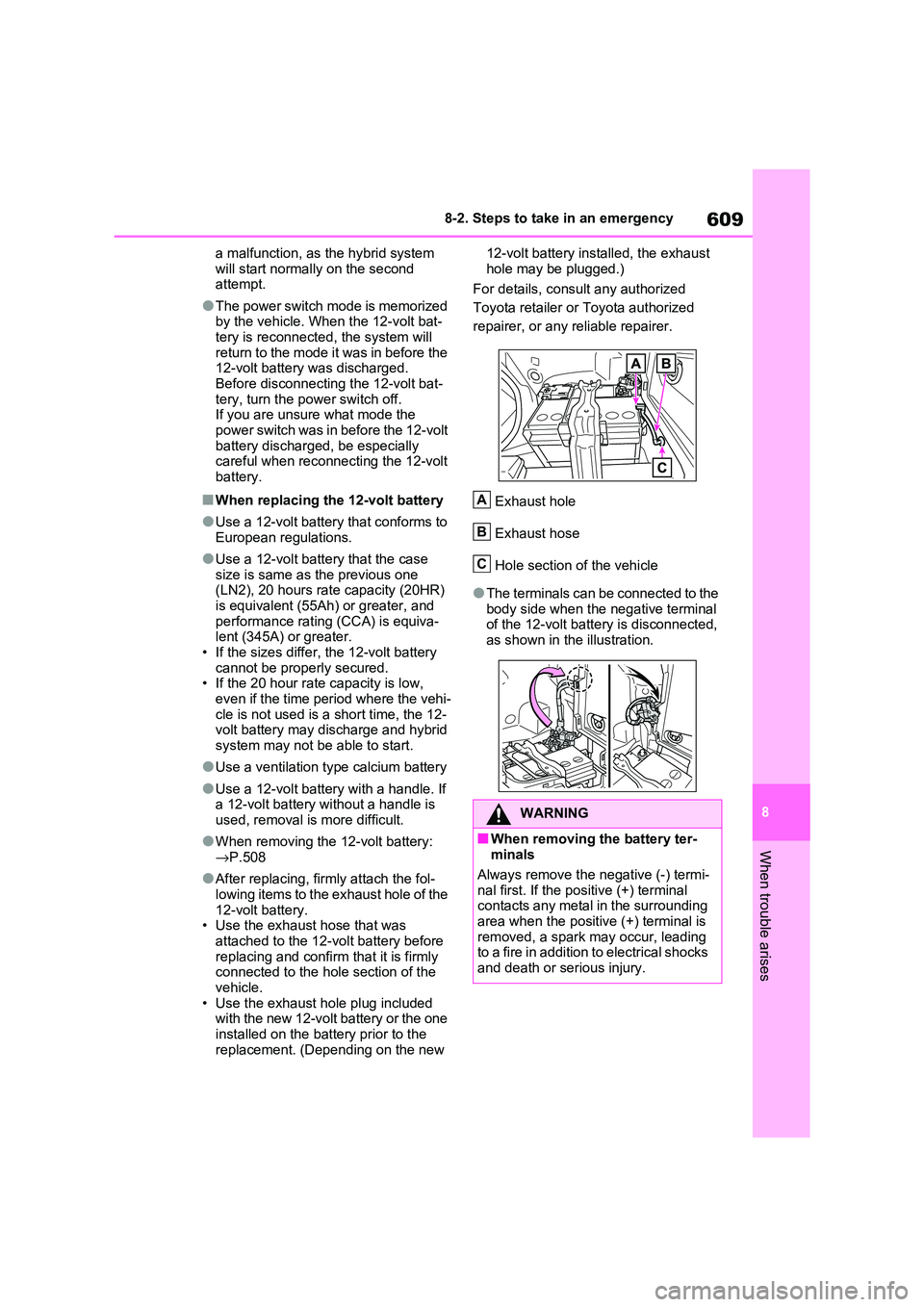
609
8
8-2. Steps to take in an emergency
When trouble arises
a malfunction, as the hybrid system
will start normally on the second attempt.
●The power switch mode is memorized by the vehicle. When the 12-volt bat-
tery is reconnected , the system will
return to the mode it was in before the 12-volt battery was discharged.
Before disconnecting the 12-volt bat -
tery, turn the power switch off. If you are unsure what mode the
power switch was in before the 12-volt
battery discharged, be especially careful when reconnecting the 12-volt
battery.
■When replacing the 12-volt battery
●Use a 12-volt battery that conforms to
European regulations.
●Use a 12-volt batt ery that the case
size is same as the previous one
(LN2), 20 hours rate capacity (20HR) is equivalent (55Ah ) or greater, and
performance rating (CCA) is equiva -
lent (345A) or greater. • If the sizes differ, the 12-volt battery
cannot be properly secured.
• If the 20 hour rate capacity is low, even if the time period where the vehi -
cle is not used is a short time, the 12-
volt battery may discharge and hybrid system may not be able to start.
●Use a ventilation type calcium battery
●Use a 12-volt battery with a handle. If
a 12-volt battery without a handle is used, removal is more difficult.
●When removing the 12-volt battery: → P.508
●After replacing, firmly attach the fol- lowing items to the exhaust hole of the
12-volt battery.
• Use the exhaust hose that was
attached to the 12-volt battery before replacing and confirm that it is firmly
connected to the hole section of the
vehicle. • Use the exhaust hole plug included
with the new 12-volt battery or the one
installed on the battery prior to the replacement. (Depending on the new
12-volt battery installed, the exhaust
hole may be plugged.)
For details, consult any authorized
Toyota retailer or Toyota authorized
repairer, or any reliable repairer.
Exhaust hole
Exhaust hose
Hole section of the vehicle
●The terminals can be connected to the
body side when the negative terminal of the 12-volt batte ry is disconnected,
as shown in the illustration.
WARNING
■When removing the battery ter -
minals
Always remove the negative (-) termi-
nal first. If the posi tive (+) terminal
contacts any metal in the surrounding area when the positiv e (+) terminal is
removed, a spark m ay occur, leading
to a fire in addition to electrical shocks and death or serious injury.
A
B
C
Page 612 of 666
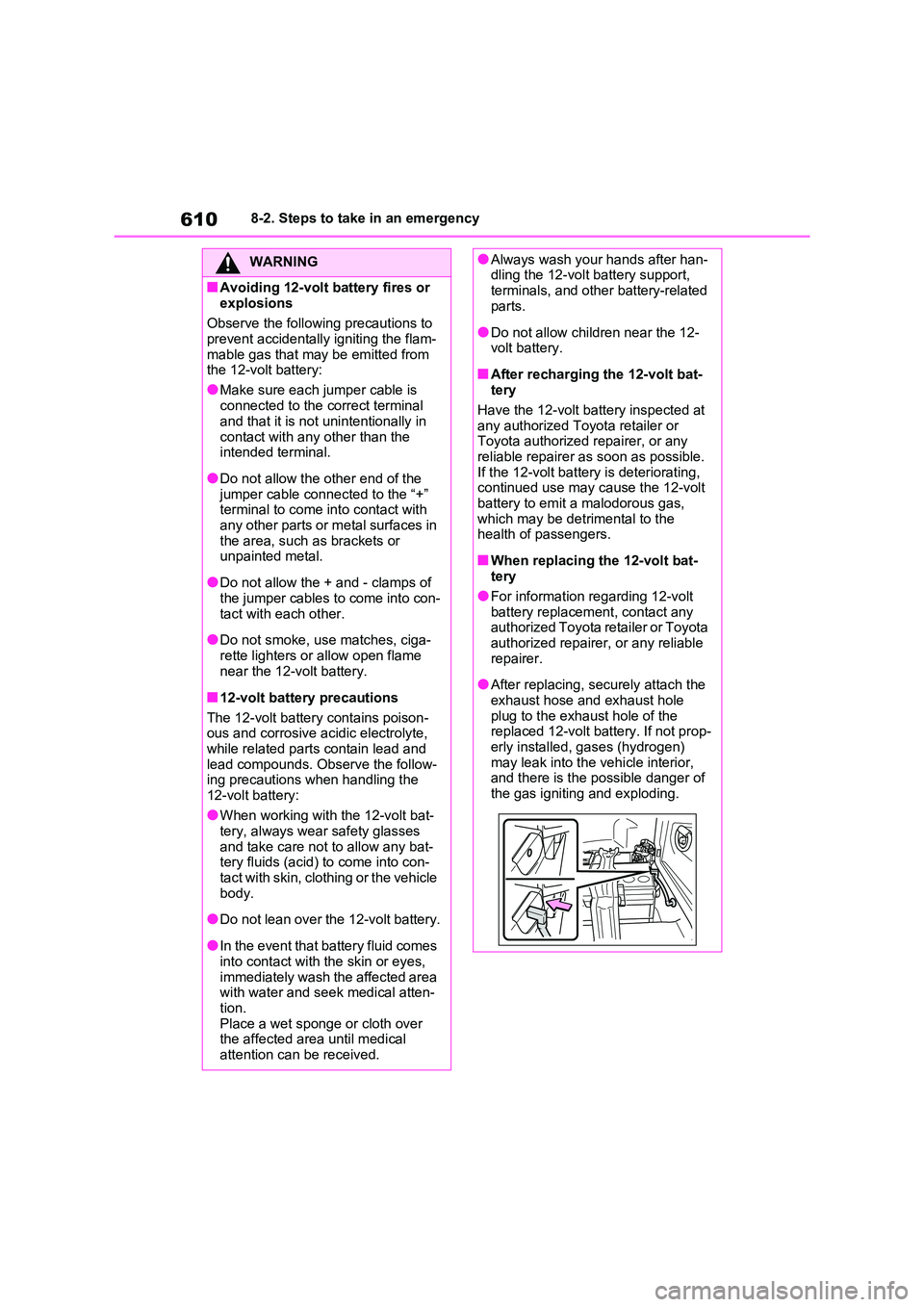
6108-2. Steps to take in an emergency
WARNING
■Avoiding 12-volt battery fires or
explosions
Observe the following precautions to prevent accidentally igniting the flam -
mable gas that may be emitted from
the 12-volt battery:
●Make sure each jumper cable is
connected to the correct terminal
and that it is not unintentionally in
contact with any other than the intended terminal.
●Do not allow the other end of the jumper cable conne cted to the “+”
terminal to come into contact with
any other parts or metal surfaces in the area, such as brackets or
unpainted metal.
●Do not allow the + and - clamps of
the jumper cables to come into con -
tact with each other.
●Do not smoke, use matches, ciga -
rette lighters or allow open flame near the 12-volt battery.
■12-volt battery precautions
The 12-volt battery contains poison -
ous and corrosive acidic electrolyte,
while related part s contain lead and lead compounds. Observe the follow -
ing precautions when handling the
12-volt battery:
●When working with the 12-volt bat -
tery, always wear safety glasses
and take care not to allow any bat - tery fluids (acid) to come into con-
tact with skin, clothing or the vehicle
body.
●Do not lean over the 12-volt battery.
●In the event that battery fluid comes
into contact with the skin or eyes,
immediately wash the affected area with water and seek medical atten -
tion.
Place a wet sponge or cloth over the affected area until medical
attention can be received.
●Always wash your hands after han - dling the 12-volt battery support,
terminals, and other battery-related
parts.
●Do not allow children near the 12-
volt battery.
■After recharging the 12-volt bat -
tery
Have the 12-volt bat tery inspected at
any authorized Toyota retailer or
Toyota authorized repairer, or any reliable repairer as soon as possible.
If the 12-volt batter y is deteriorating,
continued use may cause the 12-volt battery to emit a malodorous gas,
which may be det rimental to the
health of passengers.
■When replacing the 12-volt bat -
tery
●For information re garding 12-volt
battery replacem ent, contact any
authorized Toyota retailer or Toyota authorized repairer, or any reliable
repairer.
●After replacing, securely attach the
exhaust hose and exhaust hole
plug to the exhaust hole of the replaced 12-volt battery. If not prop -
erly installed, gases (hydrogen)
may leak into the vehicle interior, and there is the possible danger of
the gas igniting and exploding.
Page 613 of 666
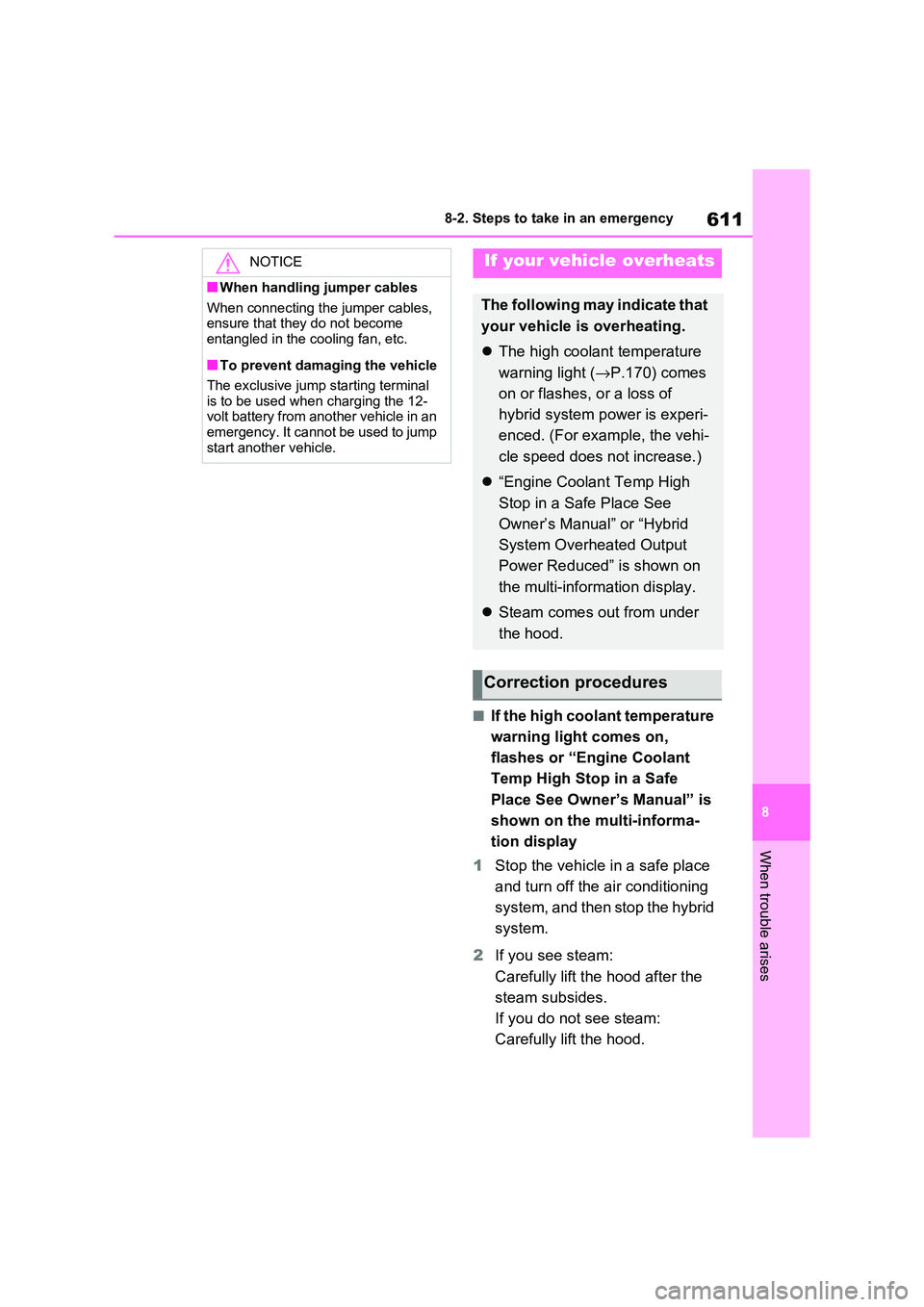
611
8
8-2. Steps to take in an emergency
When trouble arises
■If the high coolant temperature
warning light comes on,
flashes or “Engine Coolant
Temp High Stop in a Safe
Place See Owner’s Manual” is
shown on the multi-informa -
tion display
1 Stop the vehicle in a safe place
and turn off the air conditioning
system, and then stop the hybrid
system.
2 If you see steam:
Carefully lift th e hood after the
steam subsides.
If you do no t see steam:
Carefully lift the hood.
NOTICE
■When handling jumper cables
When connecting the jumper cables,
ensure that they do not become entangled in the cooling fan, etc.
■To prevent damaging the vehicle
The exclusive jump starting terminal
is to be used when charging the 12-
volt battery from another vehicle in an
emergency. It cannot be used to jump start another vehicle.
If your vehicle overheats
The following may indicate that
your vehicle is overheating.
The high coolant temperature
warning light ( →P.170) comes
on or flashes, or a loss of
hybrid system power is experi -
enced. (For example, the vehi -
cle speed does not increase.)
“Engine Coolant Temp High
Stop in a Safe Place See
Owner’s Manual” or “Hybrid
System Overheated Output
Power Reduced” is shown on
the multi-information display.
Steam comes out from under
the hood.
Correction procedures
Page 614 of 666
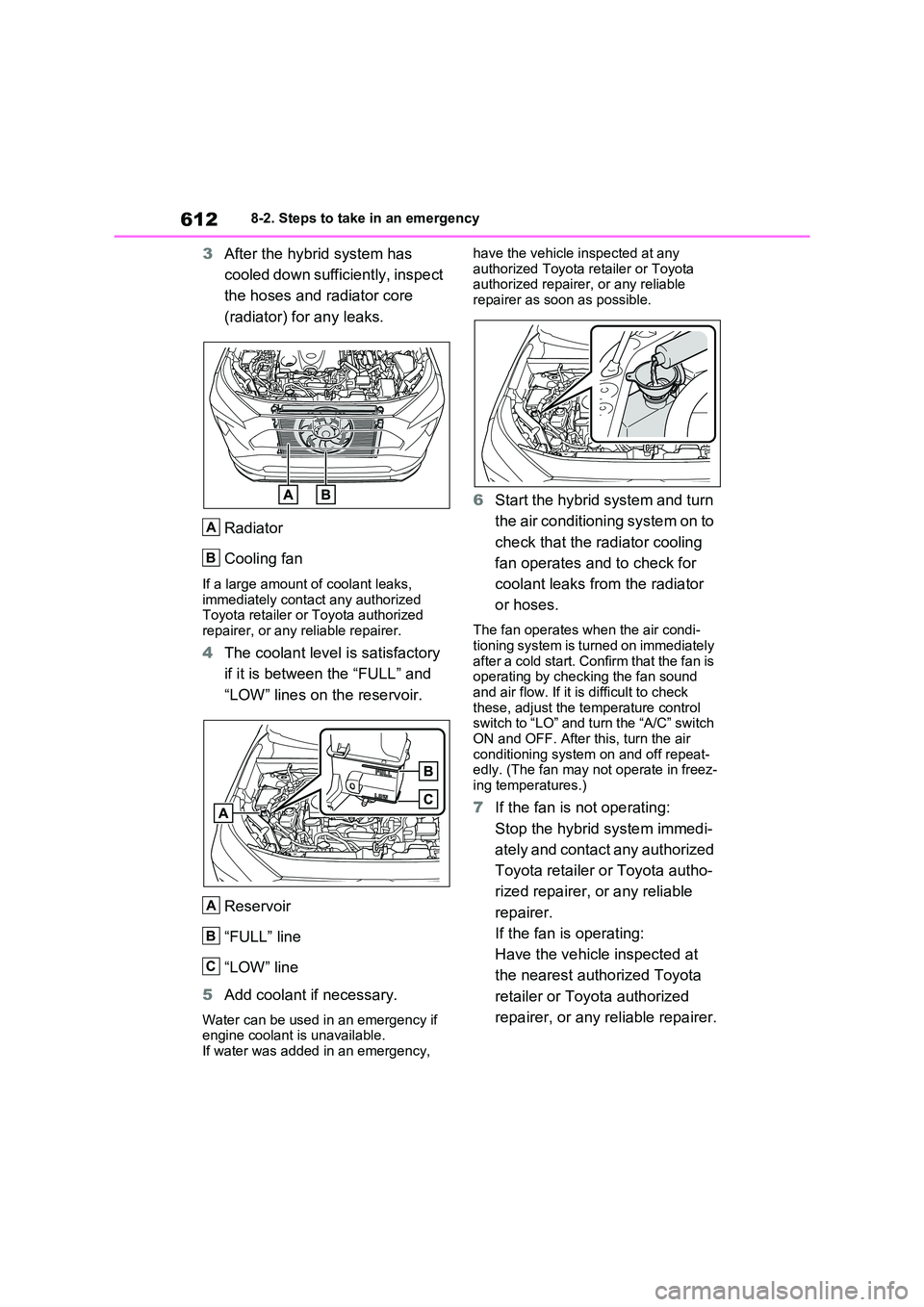
6128-2. Steps to take in an emergency
3After the hybrid system has
cooled down sufficiently, inspect
the hoses and radiator core
(radiator) for any leaks.
Radiator
Cooling fan
If a large amount of coolant leaks,
immediately contac t any authorized Toyota retailer or Toyota authorized
repairer, or any reliable repairer.
4 The coolant level is satisfactory
if it is between the “FULL” and
“LOW” lines on the reservoir.
Reservoir
“FULL” line
“LOW” line
5 Add coolant if necessary.
Water can be used in an emergency if
engine coolant is unavailable.
If water was added in an emergency,
have the vehicle i nspected at any
authorized Toyota r etailer or Toyota authorized repairer, or any reliable
repairer as soon as possible.
6 Start the hybrid system and turn
the air conditioning system on to
check that the radiator cooling
fan operates and to check for
coolant leaks from the radiator
or hoses.
The fan operates when the air condi -
tioning system is turned on immediately
after a cold start. Confirm that the fan is operating by check ing the fan sound
and air flow. If it is difficult to check
these, adjust the temperature control switch to “LO” and turn the “A/C” switch
ON and OFF. After t his, turn the air
conditioning system o n and off repeat- edly. (The fan may not operate in freez-
ing temperatures.)
7 If the fan is not operating:
Stop the hybrid system immedi -
ately and contact any authorized
Toyota retailer or Toyota autho -
rized repairer, or any reliable
repairer.
If the fan is operating:
Have the vehicle inspected at
the nearest authorized Toyota
retailer or Toyota authorized
repairer, or any reliable repairer.
A
B
A
B
C
Page 615 of 666
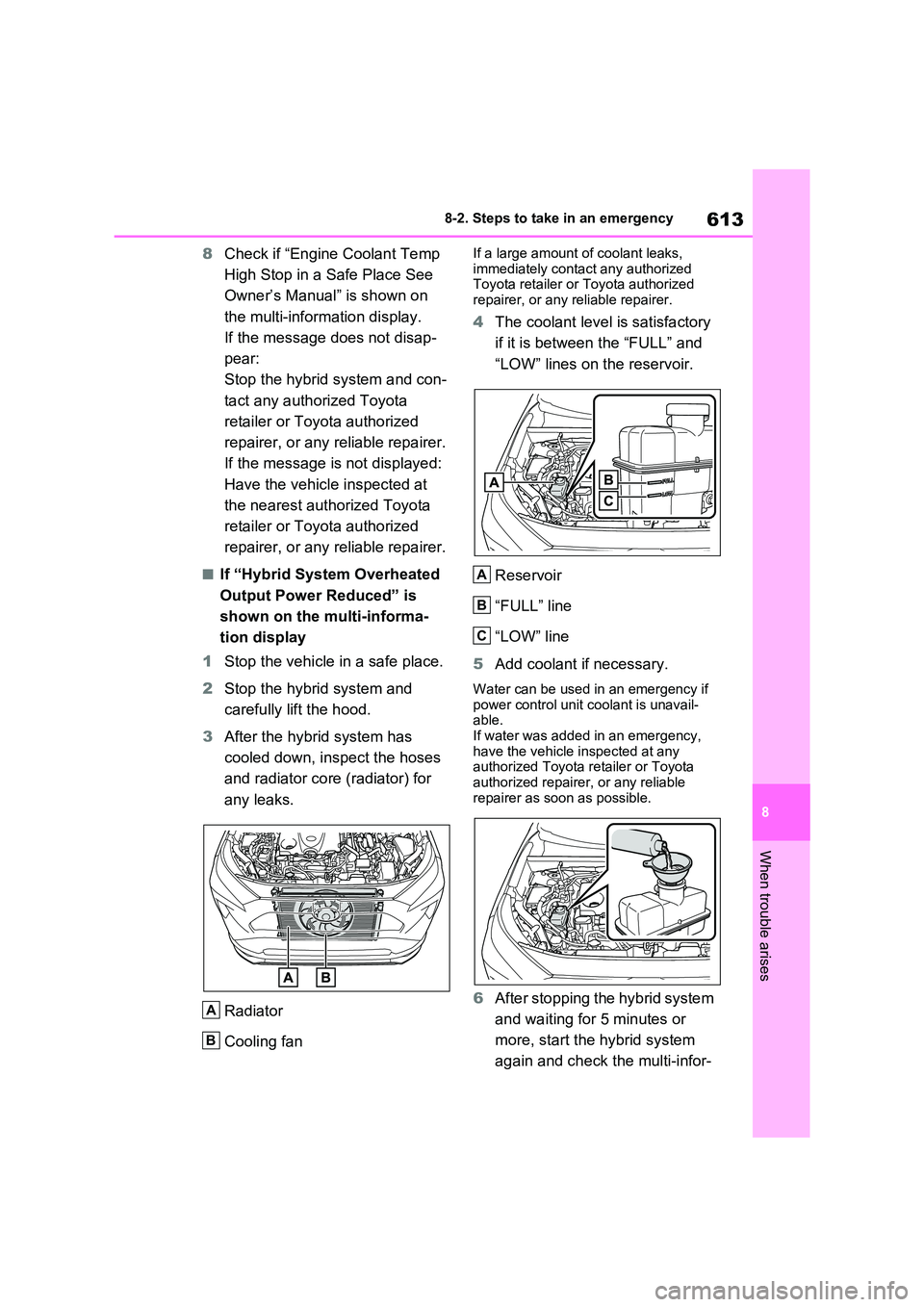
613
8
8-2. Steps to take in an emergency
When trouble arises
8 Check if “Engine Coolant Temp
High Stop in a Safe Place See
Owner’s Manual” is shown on
the multi-information display.
If the message does not disap -
pear:
Stop the hybrid system and con -
tact any authorized Toyota
retailer or Toyo ta authorized
repairer, or any reliable repairer.
If the message is not displayed:
Have the vehicle inspected at
the nearest authorized Toyota
retailer or Toyo ta authorized
repairer, or any reliable repairer.
■If “Hybrid System Overheated
Output Power Reduced” is
shown on the multi-informa -
tion display
1 Stop the vehicle in a safe place.
2 Stop the hybrid system and
carefully lift the hood.
3 After the hybrid system has
cooled down, inspect the hoses
and radiator core (radiator) for
any leaks.
Radiator
Cooling fan
If a large amount o f coolant leaks,
immediately contact any authorized Toyota retailer or Toyota authorized
repairer, or any reliable repairer.
4 The coolant level is satisfactory
if it is between the “FULL” and
“LOW” lines on the reservoir.
Reservoir
“FULL” line
“LOW” line
5 Add coolant if necessary.
Water can be used in an emergency if
power control unit coolant is unavail- able.
If water was added in an emergency,
have the vehicle i nspected at any authorized Toyota r etailer or Toyota
authorized repairer, or any reliable
repairer as soon as possible.
6 After stopping the hybrid system
and waiting for 5 minutes or
more, start the hybrid system
again and check th e multi-infor-
A
B
A
B
C
Page 616 of 666
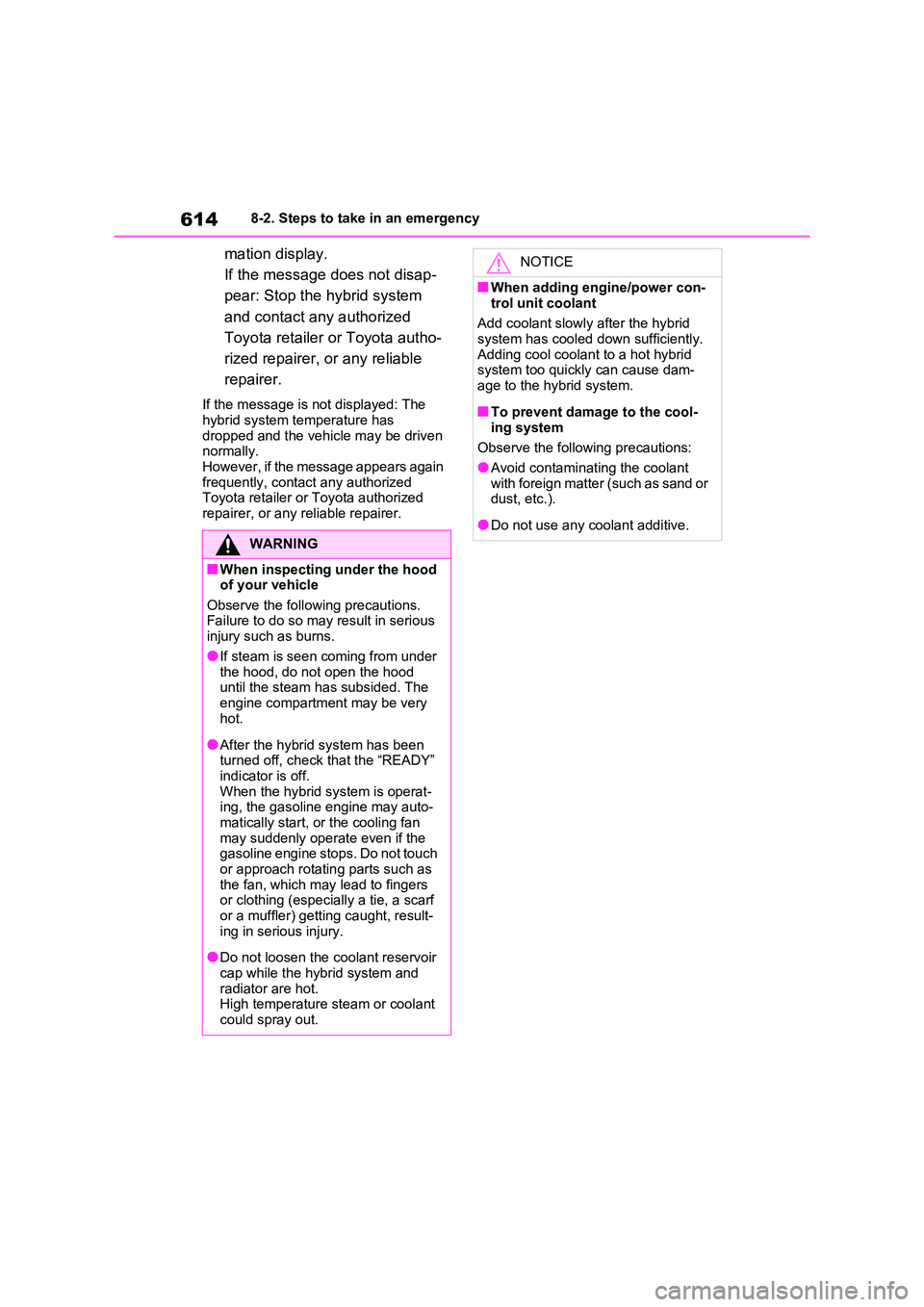
6148-2. Steps to take in an emergency
mation display.
If the message does not disap -
pear: Stop the hybrid system
and contact any authorized
Toyota retailer or Toyota autho -
rized repairer, or any reliable
repairer.
If the message is no t displayed: The
hybrid system temperature has dropped and the vehicle may be driven
normally.
However, if the message appears again frequently, contact any authorized
Toyota retailer or Toyota authorized
repairer, or any reliable repairer.
WARNING
■When inspecting under the hood of your vehicle
Observe the following precautions.
Failure to do so may result in serious injury such as burns.
●If steam is seen coming from under
the hood, do not open the hood until the steam has subsided. The
engine compartment may be very
hot.
●After the hybrid system has been
turned off, check that the “READY” indicator is off.
When the hybrid system is operat -
ing, the gasoline engine may auto - matically start, or the cooling fan
may suddenly operate even if the
gasoline engine stops. Do not touch or approach rotatin g parts such as
the fan, which may lead to fingers
or clothing (especia lly a tie, a scarf or a muffler) getting caught, result -
ing in serious injury.
●Do not loosen the c oolant reservoir
cap while t he hybrid system and
radiator are hot. High temperature steam or coolant
could spray out.
NOTICE
■When adding engine/power con -
trol unit coolant
Add coolant slowly after the hybrid system has cooled down sufficiently.
Adding cool coolant to a hot hybrid
system too quickly can cause dam- age to the hybrid system.
■To prevent damage to the cool -
ing system
Observe the following precautions:
●Avoid contaminating the coolant
with foreign matter (such as sand or dust, etc.).
●Do not use any coolant additive.
Page 617 of 666
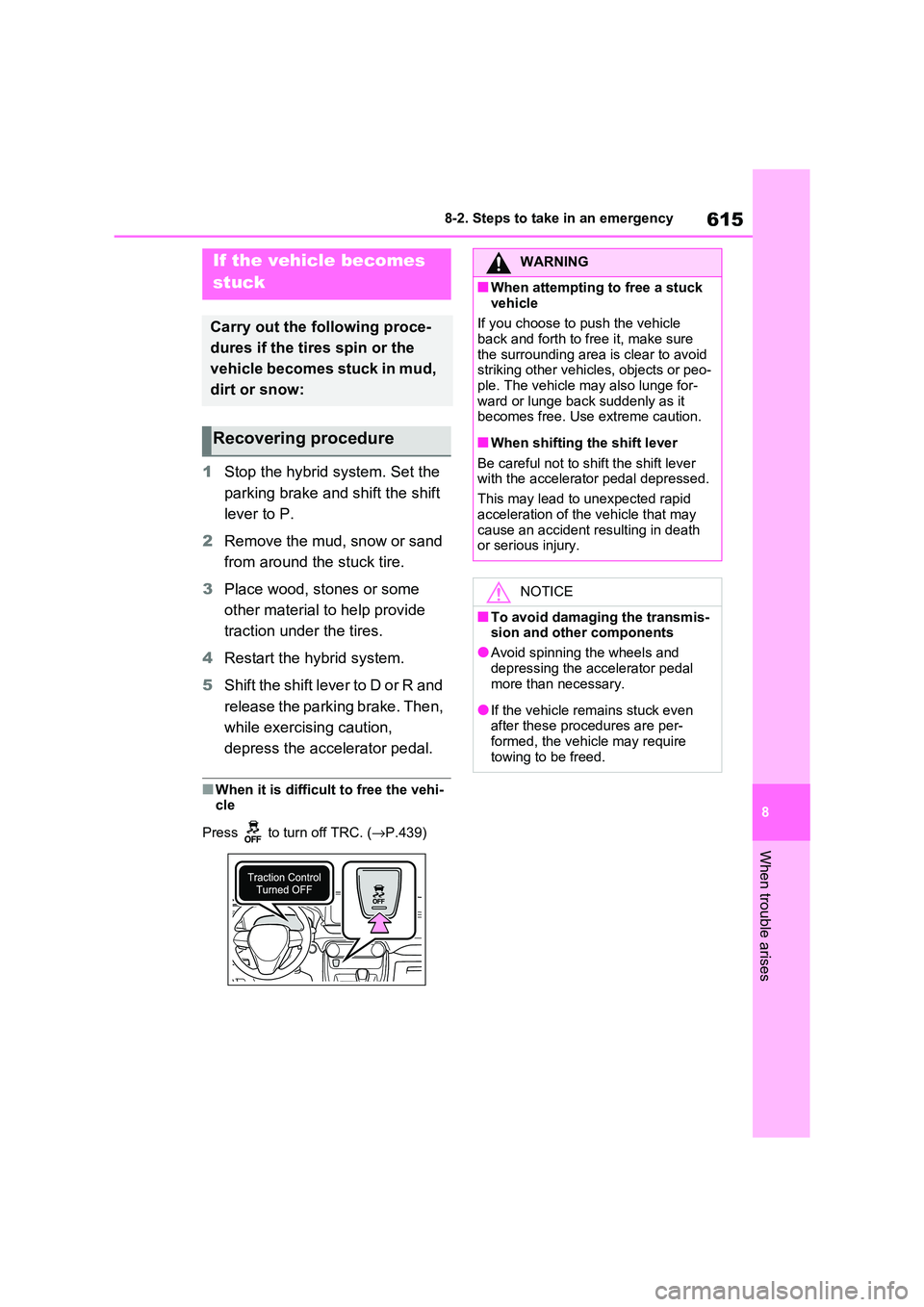
615
8
8-2. Steps to take in an emergency
When trouble arises
1 Stop the hybrid system. Set the
parking brake and shift the shift
lever to P.
2 Remove the mud, snow or sand
from around the stuck tire.
3 Place wood, stones or some
other material to help provide
traction under the tires.
4 Restart the hybrid system.
5 Shift the shift lever to D or R and
release the parking brake. Then,
while exercising caution,
depress the accelerator pedal.
■When it is difficult to free the vehi - cle
Press to turn off TRC. ( →P.439)
If the vehicle becomes
stuck
Carry out the following proce -
dures if the tires spin or the
vehicle becomes stuck in mud,
dirt or snow:
Recovering procedure
WARNING
■When attempting to free a stuck
vehicle
If you choose to push the vehicle back and forth to free it, make sure
the surrounding area is clear to avoid
striking other vehicles, objects or peo - ple. The vehicle may also lunge for -
ward or lunge back suddenly as it
becomes free. Use extreme caution.
■When shifting the shift lever
Be careful not to sh ift the shift lever
with the accelerator pedal depressed.
This may lead to unexpected rapid
acceleration of the vehicle that may
cause an accident resulting in death or serious injury.
NOTICE
■To avoid damaging the transmis - sion and other components
●Avoid spinning the wheels and
depressing the accelerator pedal
more than necessary.
●If the vehicle remains stuck even
after these procedures are per - formed, the vehicle may require
towing to be freed.
Page 618 of 666

6168-2. Steps to take in an emergency
Page 619 of 666
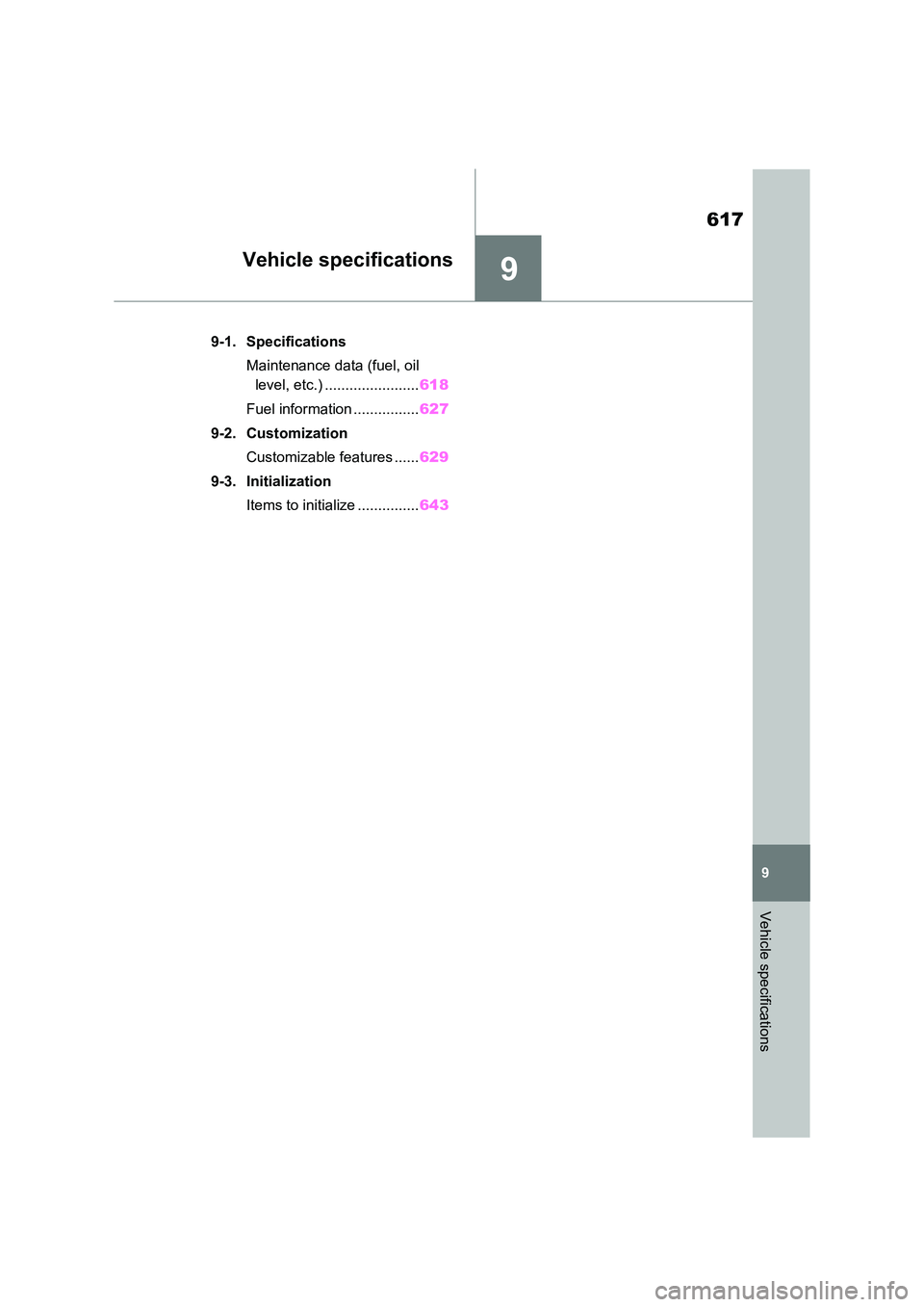
9
617
9
Vehicle specifications
Vehicle specifications
9-1. Specifications
Maintenance data (fuel, oil
level, etc.) ....................... 618
Fuel information ................ 627
9-2. Customization
Customizable features ...... 629
9-3. Initialization
Items to initialize ............... 643
Page 620 of 666
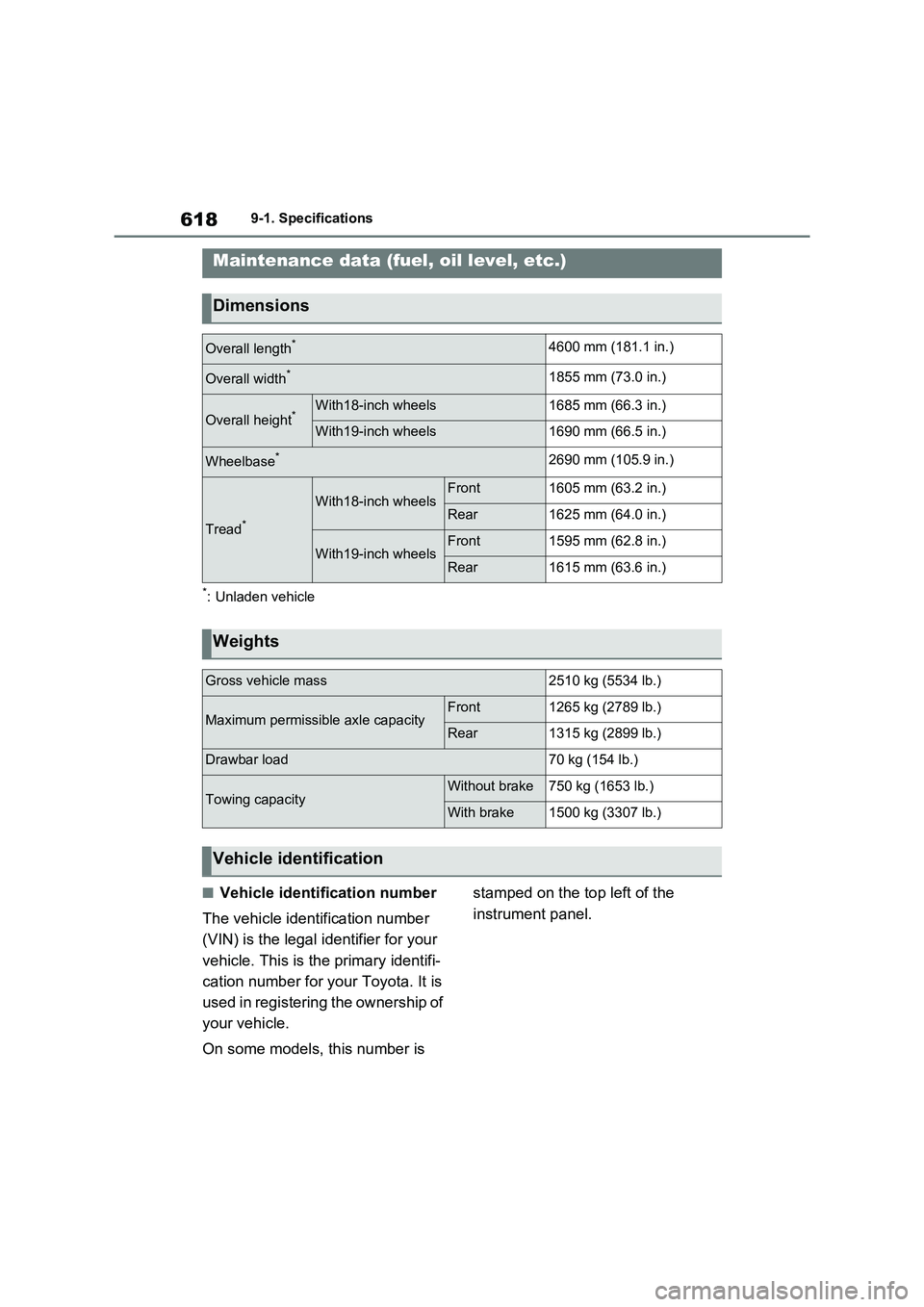
6189-1. Specifications
9-1.Specifications
*: Unladen vehicle
■Vehicle identification number
The vehicle identification number
(VIN) is the legal identifier for your
vehicle. This is the primary identifi -
cation number for your Toyota. It is
used in registering the ownership of
your vehicle.
On some models, this number is
stamped on the top left of the
instrument panel.
Maintenance data (fuel, oil level, etc.)
Dimensions
Overall length*4600 mm (181.1 in.)
Overall width*1855 mm (73.0 in.)
Overall height*With18-inch wheels1685 mm (66.3 in.)
With19-inch wheels1690 mm (66.5 in.)
Wheelbase*2690 mm (105.9 in.)
Tread*
With18-inch wheelsFront1605 mm (63.2 in.)
Rear1625 mm (64.0 in.)
With19-inch wheelsFront1595 mm (62.8 in.)
Rear1615 mm (63.6 in.)
Weights
Gross vehicle mass2510 kg (5534 lb.)
Maximum permissible axle capacityFront1265 kg (2789 lb.)
Rear1315 kg (2899 lb.)
Drawbar load70 kg (154 lb.)
Towing capacityWithout brake750 kg (1653 lb.)
With brake1500 kg (3307 lb.)
Vehicle identification